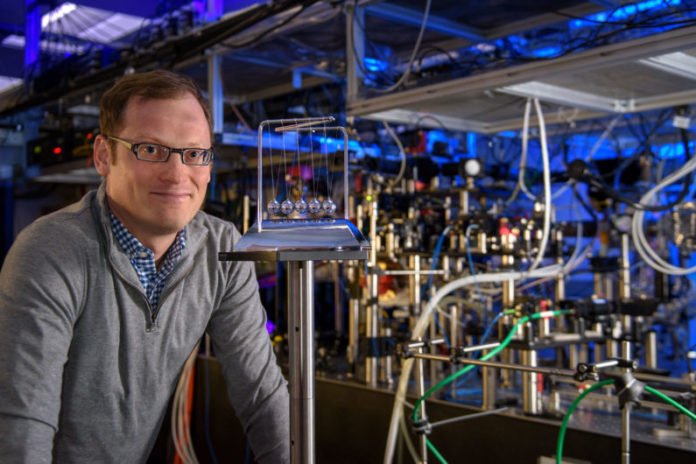Newton’s cradle is more than a popular desktop plaything. It has taught a generation of students about conservation of momentum and energy.
Now, Stanford scientists have developed their own quantum version of Newton’s cradle in order to answer questions about how the chaotic motion of quantum particles eventually leads to a thermal equilibrium in a process called thermalization.
Scientists believe that the discovery could help them better understand the behavior of quantum systems out of equilibrium – when they’re kicked.
Through this cradle, researchers for the first time observed how quantum system reaches thermal equilibrium after inducing small amounts of chaotic motion.
The turbulent swirl of milk as it’s added to coffee is a familiar example of chaos in the non-quantum world. Over time, the coffee mixture becomes homogenous and, therefore, reaches equilibrium.
Scientists wanted to know how the evolution takes place in quantum systems after they induce just a touch of chaos. Through experiments with their cradle, the researchers were the first to observe this process as it happened.
They shine laser beams through an airtight chamber to cool a gas of atoms down to nearly absolute zero – one of the coldest known gases in the universe – and then they load those atoms into an array of laser tubes that act as the structure for Newton’s cradle. Each of the 700 parallel cradles contains around 50 atoms in a row. Then, another laser kicks the atoms, starting the movement of the cradle.
Their experiment mainly includes the previous achievement of making the first quantum gas of the highly magnetic element dysprosium – tied with terbium as the most magnetic of all elements. It was atoms of dysprosium the researchers loaded into the airtight chamber.
The specialists can tune how these atoms influence their neighbors. They can influence the support to go about as if the molecules are not magnetic with the goal that it will create the intermittent movement of Newton’s cradle. Or then again they can create chaotic motion by turning up the magnetization – like Newton’s cradle with magnets tied to the circles.
Until now, physicists haven’t had a hypothesis of how thermalization emerges in unpretentiously disorganized quantum frameworks. Past research with computational reproductions has brought about differing conclusions. Presently, through their analyses, the analysts cradles oscillation that the supports’ wavering achieved balance in an arrangement of two exponential advances, which was a startling outcome.
They also confirmed their experimental results in an extensive computer simulation. Based on these experiments and simulations, the group developed a theory that explains their findings.
Benjamin Lev associate professor of physics and of applied physics at Stanford University said, “If we want to be able to create devices that are robust and useful, we need to understand how quantum systems behave out of equilibrium – when they’re kicked, like Newton’s cradle – at a level as fundamental as we understand that for classical systems.”
“Through these experiments, we can have a very general, simple theory for how complicated quantum systems like this one thermalize. That’s beautiful because it allows you to translate that to other systems.”
Already, the researchers have several experiments planned for the magnetic quantum Newton’s cradle and they anticipate many more opportunities for building upon this work as the quantum revolution evolves.
Yijun Tang, a recently graduated doctoral student in the Lev lab and lead author of the paper said, “Very sophisticated laser technologies can manipulate systems atom by atom. So, maybe what we can do will go beyond fundamental science questions. Maybe, at some point, we can turn these technologies into something more practical as well.”
Additional Stanford co-authors are Wil Kao, Kuan-Yu Li, and Sangwon Seo. Krishnanand Mallayya and Marcos Rigol of Penn State and Sarang Gopalakrishnan of the City University of New York are also co-authors. Lev is a faculty member in the School of Humanities and Sciences at Stanford.
They published their findings May 2 in Physical Review X.
